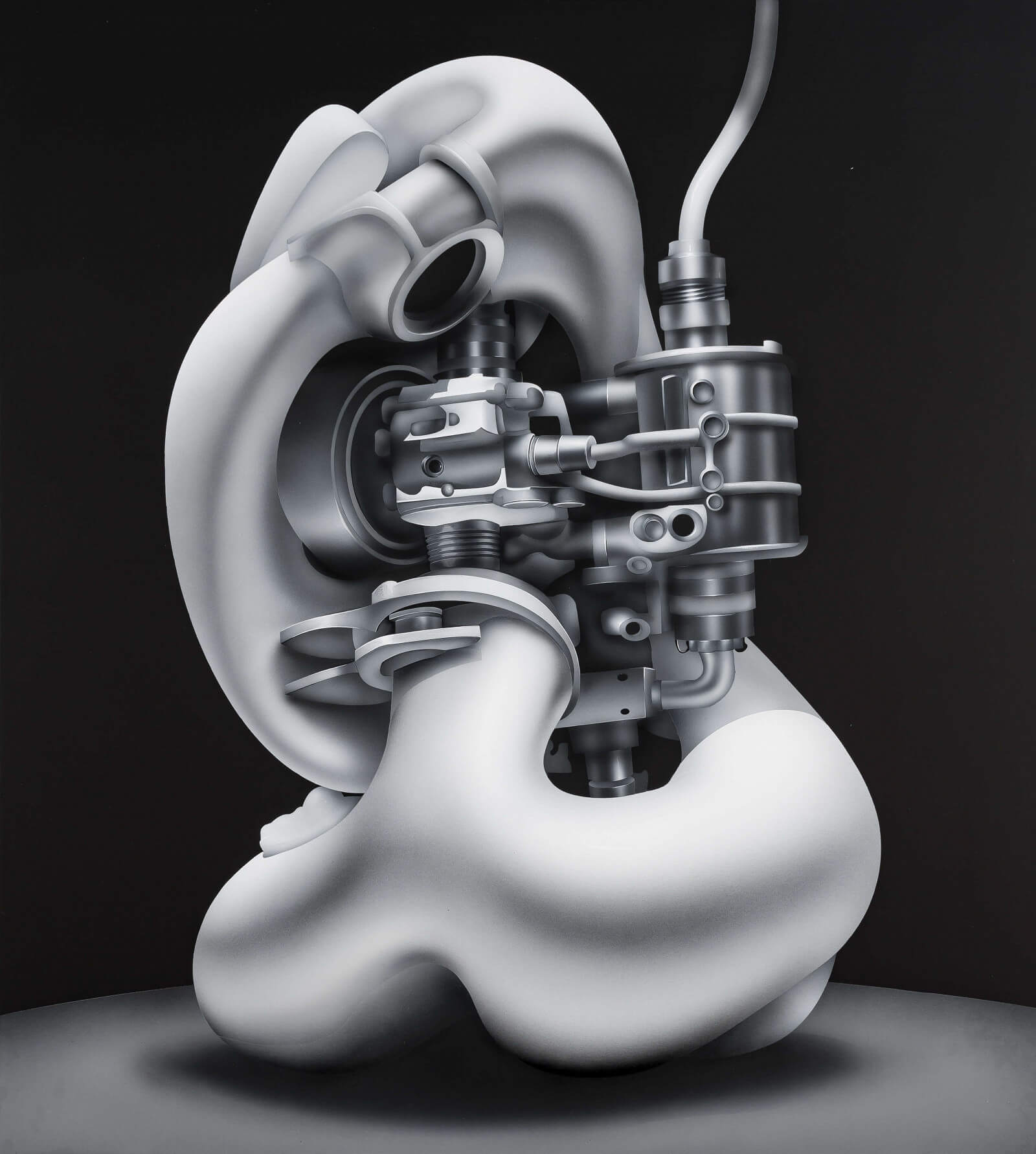Harrison Pearce
Graceful Degradation
➝ Download Press Release
I The Disruption
Is there a poetic cadence to the sounds of an MRI machine?
You look up, yet down, your body. The vibrations and halts and grinding… like metal playing in the next room.
An auditory and emotional intrusion; a profound disruption.
Pearce’s work encapsulates this state of instability, and the unsettling nature of interruptions.
The genesis of his practice is rooted in a profound disruption that prompted deeper investigation into the nature of perception. Drawing from his encounters with brain anomalies and the ensuing medical procedures, Pearce explores the indeterminacy and ambiguity inherent in understanding of our bodies. Works grapple with the emotional space within medical and technical language, and the unsettling yet universal experience of confronting the unknown in a clinical setting.
-
The paintings here are demonstrations of uncertain scenes. Familiar yet uncanny. Smoke billows from screens, and axles turn in organic forms.
Wrought in paint, machines tear and pierce, and pull and crease. They bubble and billow through flexing forms. A taffy puller, sewing machine or dystopian cake mixer. They are ‘Soft Serve’ and ‘Swell’.
Pearce interrogates a sustained dualism. Blending organic forms with mechanised components, he challenges a separation. Known and unknown. The mind and body. The sensuality of silicone with the precise automation of pneumatics. The exhibition title itself encapsulates this oxymoronic structure. “Graceful Degradation” (an engineering term) juxtaposes “graceful”— evoking lifting and lightness — with “degradation”—implying falling and failing. This dichotomy is central to his presented experience. As Pearce paints with airbrush and builds with air, he shines a light on both the deep black voids, and that which resists the fall into nothingness.
Many titles here communicate these double and deeper meanings, such as ‘Yield’ (to give in and to provide). ‘Maladapted,’ comments on our status as beings maladapted to reality.
Here, you look up, and down the rising, spiralling building here at the diptych overhead. It pulls your attention, as its fight ensues. Both pincer and pierced. Both sides, stark in contrast yet joined in mission, drag you left and right.
II The Sound
The noises: a mechanical sentence of dots and dashes. A clanging morse code arranging the water in your body. Unstable yet sophisticated.
Rhythmic pulses and jarring sounds embody both the intrusion of technology into the body and a confrontation with the unfamiliar.
A break and a rhythm. An act of distorted arrangement.
–
There is powerful music in this orchestrated display, expertly created through an on-site, live, original composition developed by Liam Byrne in ‘Maladapted’ and Steven Atkinson in both ‘Manifold’ and ‘Yield’.
Here, the sounds of the viol da gamba, an instrument rich in history, have been transformed to trigger percussive elements, creating a complex, generative, and responsive immersion.
Stratified by the building’s staircase, this slowed-down, textural sound – at one time akin to a growling motorbike or whirring drive – shifts the renaissance string instrument into a machine-like foreboding. Clicks and whirrs agitate the sculptures. They force them to yield under pressure. They force them to transform.
This is a space where the boundaries between organic and engineered dissolve, inviting a reconsideration of our relationship with the machines that increasingly shape our lives while presenting a poignant exploration of the limits of language, the nature of consciousness, and the enduring quest for understanding.
Within the context of industrialisation and post-romanticism, Pearce’s works examine how humankind has historically sought to control nature through experimentation and intervention, striving for truth – for knowledge. Pearce’s work transcends traditional boundaries, inviting us to explore the profound and often disquieting intersections of mind, body, and machines.
His work suggests that contemporary society is experiencing a rupture, where boundaries and certainties are dissolving. This dissolution is reflected in the blurring between borders, genders, and the self, amidst the broader epistemological chaos of the modern world around us.
III The Unknown
With an MRI comes some waiting.
Pearce’s art embodies the idea: “What is it like not to know?”
This question becomes an aesthetic experience, as he embraces the ambiguity that comes with medical and technological interventions: how technologies influence our understanding of reality, diving into the philosophical implications of medical imaging.
MRI images are not like that of an X-Ray. They are computational. They must be deciphered and translated according to a predetermined ‘ideal’ of an ideal body. Sophisticated images appear definitive but are imbued with ambiguity. They prompt questions about what they truly represent.
Making the invisible visible, both scans and Pearce’s work question the reliability of visual perception and the role of existing knowledge in decoding abstract forms.
Here, light and form suggest surfaces - clangy, jelly, rubber surfaces.
Is what you are looking at a function, or a fault? Does ‘The Certainty of…’ present the smoke plume of a breakdown, or a purposeful, bubbling production?
Decoding these scans mirrors the artist’s journey through medical uncertainty, capturing the tension between clarity and ambiguity.
Pearce’s works delve into the ‘epiphenomenology of experience,’ transforming physical descriptions of the body into visual and kinetic forms. These pieces explore the gap between physical reality and conscious experience, highlighting the strangeness of certainty and the pervasive recurrence of uncertainty.
An understanding to live with indeterminacy as an acceptable state.
Mollie Barnes

